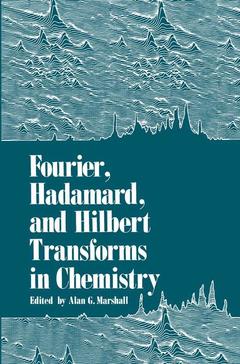Description
Fourier, Hadamard, and Hilbert Transforms in Chemistry, Softcover reprint of the original 1st ed. 1982
Author: Marshall Alan
Language: English
Subject for Fourier, Hadamard, and Hilbert Transforms in Chemistry:
Keywords
Approximative price 210.99 €
In Print (Delivery period: 15 days).
Add to cart
Publication date: 06-2013
562 p. · 15.5x23.5 cm · Paperback
562 p. · 15.5x23.5 cm · Paperback
Description
/li>Contents
/li>
In virtually all types of experiments in which a response is analyzed as a function of frequency (e. g. , a spectrum), transform techniques can significantly improve data acquisition and/or data reduct ion. Research-level nuclear magnet ic resonance and infra-red spectra are already obtained almost exclusively by Fourier transform methods, because Fourier transform NMR and IR spectrometers have been commercially available since the late 1960·s. Similar transform techniques are equally valuable (but less well-known) for a wide range of other chemical applications for which commercial instruments are only now becoming available: for example, the first corrmercial Fourier transform mass spectrometer was introduced this year (1981) by Nicolet Instrument Corporation. The purpose of this volume is to acquaint practicing chemists with the basis, advantages, and applica of Fourier, Hadamard, and Hilbert transforms in chemistry. For tions almost all chapters, the author is the investigator who was the first to apply such methods in that field. The basis and advantages of transform techniques are described in Chapter 1. Many of these aspects were understood and first applied by infrared astronomers in the 1950·s, in order to improve the otherwise unacceptably poor signal-to-noise ratio of their spec tra. However, the computations required to reduce the data were painfully slow, and required a 1 arge computer.
Advantages of Transform Methods in Chemistry.- Hadamard and Other Discrete Transforms in Spectroscopy.- Processing Software for Fourier Transform Spectroscopies.- Dispersion versus Absorption (DISPA): Hilbert Transforms in Spectral Line Shape Analysis.- Fourier Transform Ion Cyclotron Resonance Spectroscopy.- Fourier Transform Nuclear Quadrupole Resonance Spectroscopy.- Fourier Transform Dielectric Spectroscopy.- Pulsed Fourier Transform Microwave Spectroscopy.- Two-Dimensional Fourier Transform NMR Spectroscopy.- Endor Spectroscopy by Fourier Transformation of the Electron Spin Echo Envelope.- Advances in FT-NMR Methodology for Paramagnetic Solutions: Detection of Quadrupolar Nuclei in Complex Free Radicals and Biological Samples.- Fourier Transform ?SR.- Fourier Transform Infrared Spectrometry.- Aspects of Fourier Transform Visible/UV Spectroscopy.- Fourier Transform Faradaic Admittance Measurements (FT-FAM): A Description and Some Applications.- Optical Diffraction by Electrodes: Use of Fourier Transforms in Spectroelectrochemistry.- List of Contributors.
© 2024 LAVOISIER S.A.S.

